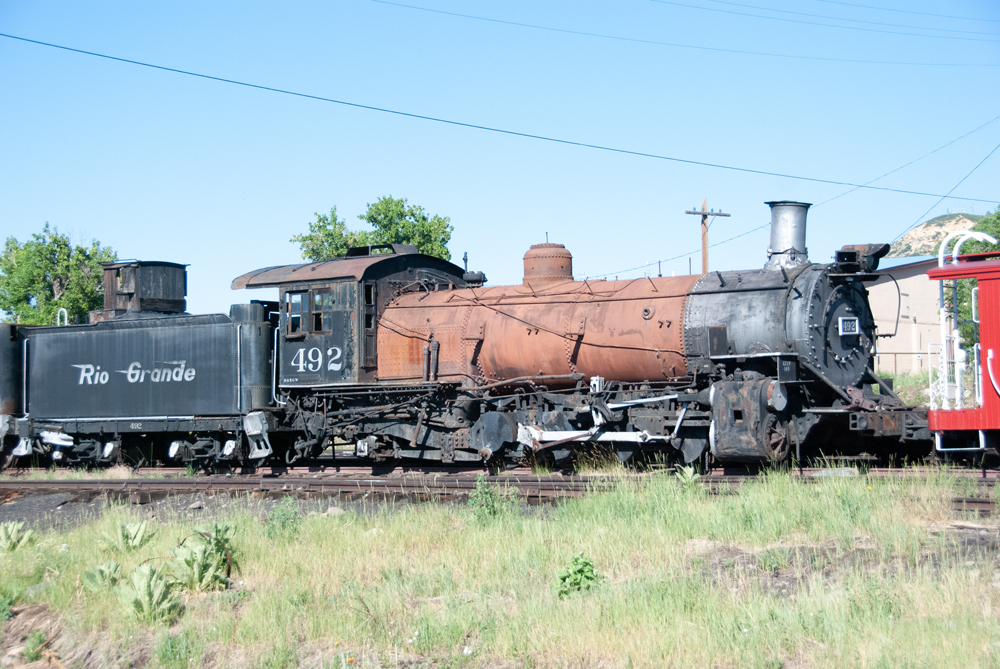
CHAMA, N.M. — We may yet see a Rio Grande K-37 climb Cumbres Pass once more.
On Saturday, the two-state commission that oversees the Cumbres & Toltec Scenic Railroad voted to restore a Rio Grande K-37 2-8-2, returning that model to the 64-mile narrow gauge railroad for the first time since 2002 when No. 497 ended service. The railroad has both No. 497, restored to operation in 1984, and No. 492, which hasn’t steamed since the Rio Grande shut down regular freight operations on the narrow gauge in 1968.
C&TS President and Colorado Commissioner Scott Gibbs tells Trains News Wire that both locomotives will be evaluated to determine the best restoration candidate. The addition would give the railroad five large locomotives necessary to cover the regular schedule, engineer/fireman schools, and special events, he says. No timetable was established for the evaluation or overhaul.
The K-37 Rio Grande Mikados are unique because they were built as standard gauge Consolidations in 1902, with 10 converted to narrow gauge between 1928-1930. Of the eight survivors, two others are in operation. No. 491 at Colorado Railroad Museum in Golden was restored in 2014, and No. 493 was restored as an oil-burner at Durango & Silverton in 2020. It was the star of a Trains Magazine photo charter in September 2021.
In other CT&S commission news, Gibbs reported in a post to the Narrow Gauge Discussion Forum:
— Restoration on the Osier dining hall, damaged by fire in late 2021, will resume in the spring with the aim of being ready for the railroad’s June 11 opening day. Restoration will cost more than $1 million.
— The Commission approved a resolution to build a secure storage building for the railroad’s newly restored historic-car consist and 4-6-0 No. 168 in Antonito. Plans call for construction this summer, with funding from the railroad’s Historic Preservation Account.
— Updated at 12:35 p.m. on Feb. 15 to correct that conversion was from standard-gauge Consolidation locomotives.














Actually, the K-37’s got all-new frames, running gear and cylinders to become narrow gauge 2-8-2’s from standard gauge 2-8-0’s.
The tender trucks were regauged as is. Take a look: the journal boxes and truck frames are still set up for RR gauge while the wheels are waaay inside at 3′ gauge.
C&TS has 5 K-36 engines but 483 hasn’t run in decades and is apparently untouchable. That leaves one of the K-37’s to be overhauled.
The 492 is not in Antonito, it is in Chama along with the 497. There was speculation they would take the best parts of 497 and 492 and use them in one locomotive but that raised some ire among fans. Decisions still to be made.
“ The K-37 Rio Grande Mikados are unique because they were built as standard gauge Mikados…” Wanna bet? Jim should be giving someone a tongue lashing right about now.
The K 37s were built as standard gauge 2-8-0 engines and later rebuilt to operate as 2-8-2 Mikados on the 3 foot gauge lines then still active in southwestern Colorado. This was done by adding a trailing truck/wheel-set under the firebox and re-gauging all the wheels and drivers.
They (K 37s) could not run on the original narrow gauge mainline west of Gunnison thru the Black Canyon, or on the Santa Fe branch, nor on the Silverton branch (although that has now been fixed with bridge reinforcements and better rail/ballast), but they gave the D&RGW a powerful locomotive for longer/heavier freights and helper service. They were never as popular with crews as the K 36 Class 2-8-2s built specifically for the narrow gauge lines.
The smaller K 27s (“Mudhens”) could run on less well built track like the Antonito-Santa Fe branch and on the affiliated Rio Grande Southern, while the K 28 (“Sport-models”) were preferred for “fast(er)” narrow gauge mainlines passenger services.
In Rio Grande days the only Mikado types allowed to go to Silverton were the K 27 and K 28 Class engines–although, as noted above, upgrades to the Durango and Silverton Narrow Gauge RR of today permit any surviving former Rio Grande steam engine to go to Silverton (and for that matter over Cumbres Pass on the C&TS as well).